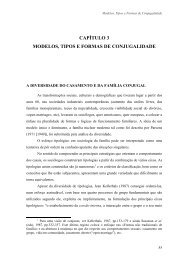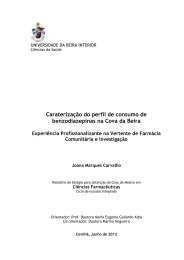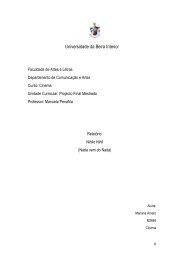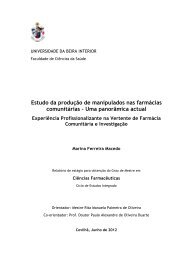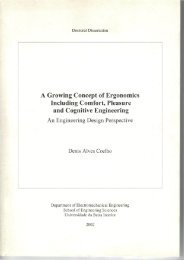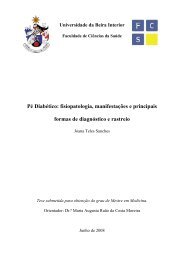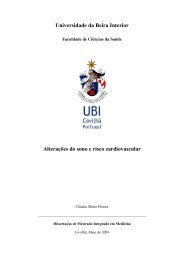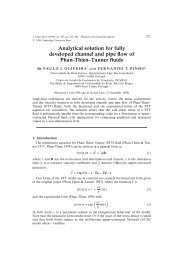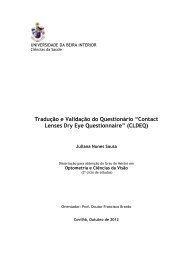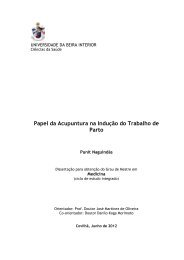Tese_Tânia Vieira.pdf - Ubi Thesis
Tese_Tânia Vieira.pdf - Ubi Thesis
Tese_Tânia Vieira.pdf - Ubi Thesis
Create successful ePaper yourself
Turn your PDF publications into a flip-book with our unique Google optimized e-Paper software.
Chapter I - Introduction<br />
2012). Protective polymers can coordinate metal ions before reduction (Mohammed Fayaz et al.<br />
2009), forming a polymer-metal ion complex, which can then be reduced to form zerovalent<br />
metal colloids (Radziuk et al. 2007; Domingos et al. 2011). This process allows the production of<br />
nanoparticles with a narrower size distribution, than those obtained without protective polymers<br />
(Mohammed Fayaz et al. 2009). Once the reduction occurs, particles are attached to the much<br />
larger protecting polymers that cover or encapsulate the metallic particles and thus stabilize<br />
them to be used in biomedical field (Mohammed Fayaz et al. 2009). In order to be applied in the<br />
referred field, is also required that both the stabilizing and the reducing agents must not<br />
represent a biological hazard (Mohammed Fayaz et al. 2009).<br />
Besides the problem of aggregation, as already described, typically AgNPs are likely to be<br />
toxic for cells under physiological conditions, which limits their applications in biological systems<br />
(Potara et al. 2011). The polymers and surfactants, used to stabilized AgNPs, are also used to<br />
solve the cytotoxic problems (Ghosh et al. 2010) and can also lead to synergistic antibacterial<br />
agents with new, improved optical, electrical and catalytic properties, unavailable in the<br />
individual components themselves (Maneerung et al. 2008; Potara et al. 2011). Thus, the use of<br />
the stabilizing agents in order to avoid aggregation, also provide a protective interfacial barrier<br />
between the metal core and cells, which is especially important for preventing damage to the<br />
surrounding healthy tissues (Schrand et al. 2008). Moreover, it was demonstrated that the<br />
incorporation of AgNPs into polymers create a protective interfacial barrier that do not affect<br />
the antibacterial properties of the nanoparticles and may increase them, as mentioned before<br />
(Schrand et al. 2008). All these advantages have been widely employed in a vast number of<br />
engineering and technical areas, especially in medical field, to produce biomedical devices with<br />
specific properties (Prashantha et al. 2006; Liu et al. 2008; Maneerung et al. 2008).<br />
Chitosan and dextran were used in this work to stabilize AgNPs in order to widening its<br />
applications.<br />
1.3.5.1. Dextran<br />
Dextran (Figure 3) is a bacterial-derived polysaccharide generally produced by enzymes<br />
from certain strains of Leuconostoc or Streptococcus (Xiao et al. 2009), with good<br />
biodegradability and biocompatibility (Wang et al. 2011). It is built by glucose molecules<br />
containing 17-20% sulfur coupled into long branched chains, mainly through 1,6-glucosidic and<br />
some through 1,3-glucosidic linkages (Tiyaboonchai et al. 2007; Hwang et al. 2010; Anitha et al.<br />
2011; Saboktakin et al. 2011; Wang et al. 2011).<br />
Moreover, it is also colloidal, water-soluble, and inert to biological systems (Hwang et al.<br />
2010; Jeong et al. 2011). Due to these properties, dextran has been studied to be used as a<br />
carrier system for a variety of therapeutic agents including antidiabetic, antibiotic, anticancer,<br />
peptides, and enzymes (Hwang et al. 2010). It has been also investigated to be used as an<br />
antiviral agent, in the treatment of hypolipidemia, and for the prevention of free radical<br />
damage, among other applications (Saboktakin et al. 2011).<br />
16




